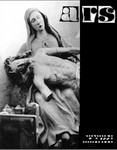
Časopis ARS 38 (2005) 2
Martin VANČO
Rím alebo Judea? Príspevok k ikonografii a proveniencii slonovinovej pyxidy z Čiernych Kľačian[Judea or Rome? Contribution to the Iconography and Provenance of Ivory Pyxis from Čierne Kľačany]
(Resumé)
Several fragments of an ivory pyxis were found during building works near Čierne Kľačany in the Zlaté Moravce’s neighbourhood in 1974. The discovery of the ivory pyxis is very important for the Slovak history of art because such a kind of late Ancient or Byzantine art is rare in our area. That is why ivory pyxis was reconstructed by experts from the Archaeological Institute of Nitra. Pyxis has probably high 8,5 cm and diameter 14,5 cm. The mantel of pyxis was carved in a low relief consists of cutting linear lines of figure’s details. Any architectonic frames did not separate the particular figural scenes from each other. Therefore it can be assumed that on the relief there is a narrative scene depicted. Under the damaged arcade there is situated only a figure of an orans, consisting of his right raised hand. On the right side of the destructed part of pyxis with orans is depicted a ploughman putting two oxes to work. In front of oxes, there is a walking woman holding a basket with food in her left hand. Her right raised arm is depicted as greeting to a ploughman. Next composition consists of a shepherd with sheep and a goat. The shepherd is sitting and his right hand is stretching out towards an unrecognizable figure. Below him lies a sheep with its head turned towards a woman. Other sheep are lying by the right side of a damaged figure. Last animal, probably a goat, is situated above them by a lock of the pyxis. All of the depicted figures are dressed in tunica, except a shepherd dressed in goat’s skin.
This unique relic has been interpreted till today solely by Slovak archaeologists Ladislav Veliačik and Titus Kolník. They interpreted pyxis like late antique product from the 1st third of the 4th Century made in Rome. They also identified iconography of the pyxis as the Legend about the Founding of Rome proceeding from the assumption that the pyxis had been created for a special occasion of the founding of New Rome - Constantinople by Constantine the Great. This hypothesis comes from the interpretation of scene with a ploughman working with two oxes, which might be seen as a symbolic act of the founding Rome by Romulus. All things considered, the pyxis cannot to be dated to the 1st half of 4th Century because majority of the well known pyxides come from 5th to 6th Century and the oldest examples is “The Great Berlin pyxis” made around 400 AC with the fries depicting Christ and the Apostles and Abraham’s Sacrifice of Issac. The Berlin pyxis reflects realism and plasticity of Roman sculpture of the 4th Century; on the contrary, the relief of Čierne Kľačany’s pyxis is low with schematic draperies of figures and stiff gestures. These significant features are typical for the Early Byzantine period of the 5th and 6th Century. Such a process of schematization and minimalisation from monumental sculpture into small works is better documented on the examples of ivory carvings.
The figural scene on the pyxis could have been interpreted also as the Old Testament’s legend Jacob Obtains Isaac’s Blessing (Gn. 27, 15-23). On the mantel of pyxis there might have been depicted: Esau – a ploughman with two oxes in the field, Rebecca – a woman holding a basket with food, Jacob – a shepherd dressed into goatskin with sheep and a goat, Isaac – a damaged figure in front of Jacob. Rebecca dressed Jacob goatskin so that Isaac would not distinguish his hand from the more hairy one of Esau. This motif is probably depicted in a bucolic scene where we can see a shepherd Jacob stretching his hand towards bending figure of Isaac. From Christian iconography point of view a shepherd – Jacob can be considered to be the Christ’s prefiguration of the Good Shepherd. All in all, it might have been Jesus Christ who was depicted as an orans standing under the arcade, what may be confirmed by the fragment of a figure with its right raised arm.
From the art historical point of view, a lot of features of the pyxis from Čierne Kľačany are comparable with a pyxis with “Pastoral scenes from British Museum”, made in Egypt during 6th Century. The scenes depict goatherds and shepherdesses playing horns and cymbals, among goats and sheep. Another important work that has to be mentioned in context of this pyxis is the Maximian’s Throne, Maximian – the Archbishop of Ravenna in 546 – 556. There are comparable relief’s panels with various scenes from the life of Jacob’s son Joseph. Tables with scenes from Joseph’s life are usually attributed to egyptian-coptic workshop like the pyxis with Pastoral scenes mentioned above. Another important fact is that, Čierne Kľačany pyxis has just an iconographical relation with the Maximian’s Throne because reliefs with motifs from Joseph’s life are close due to Joseph’s father Jacob. That is why the pyxis from Čierne Kľačany could have been made in Egyptian-coptic ivory workshop.